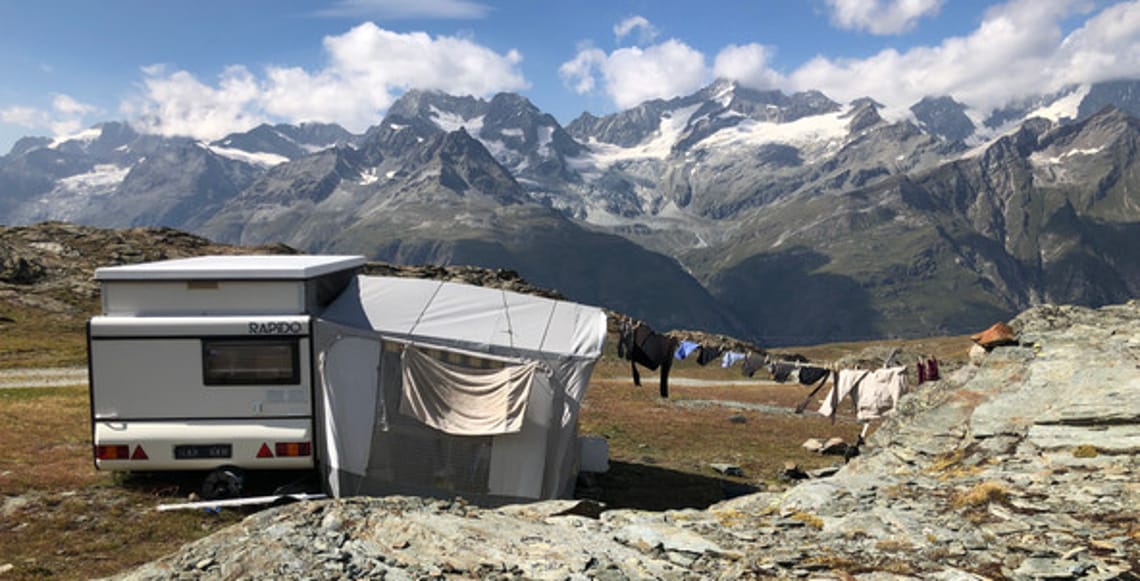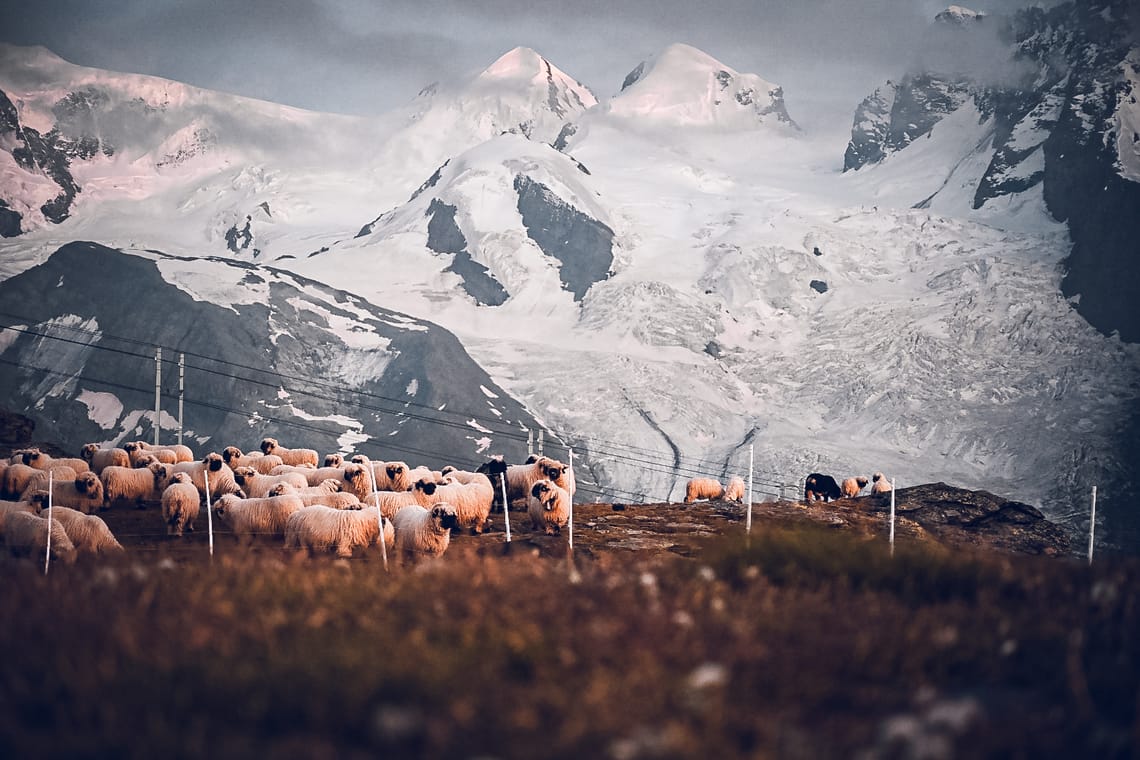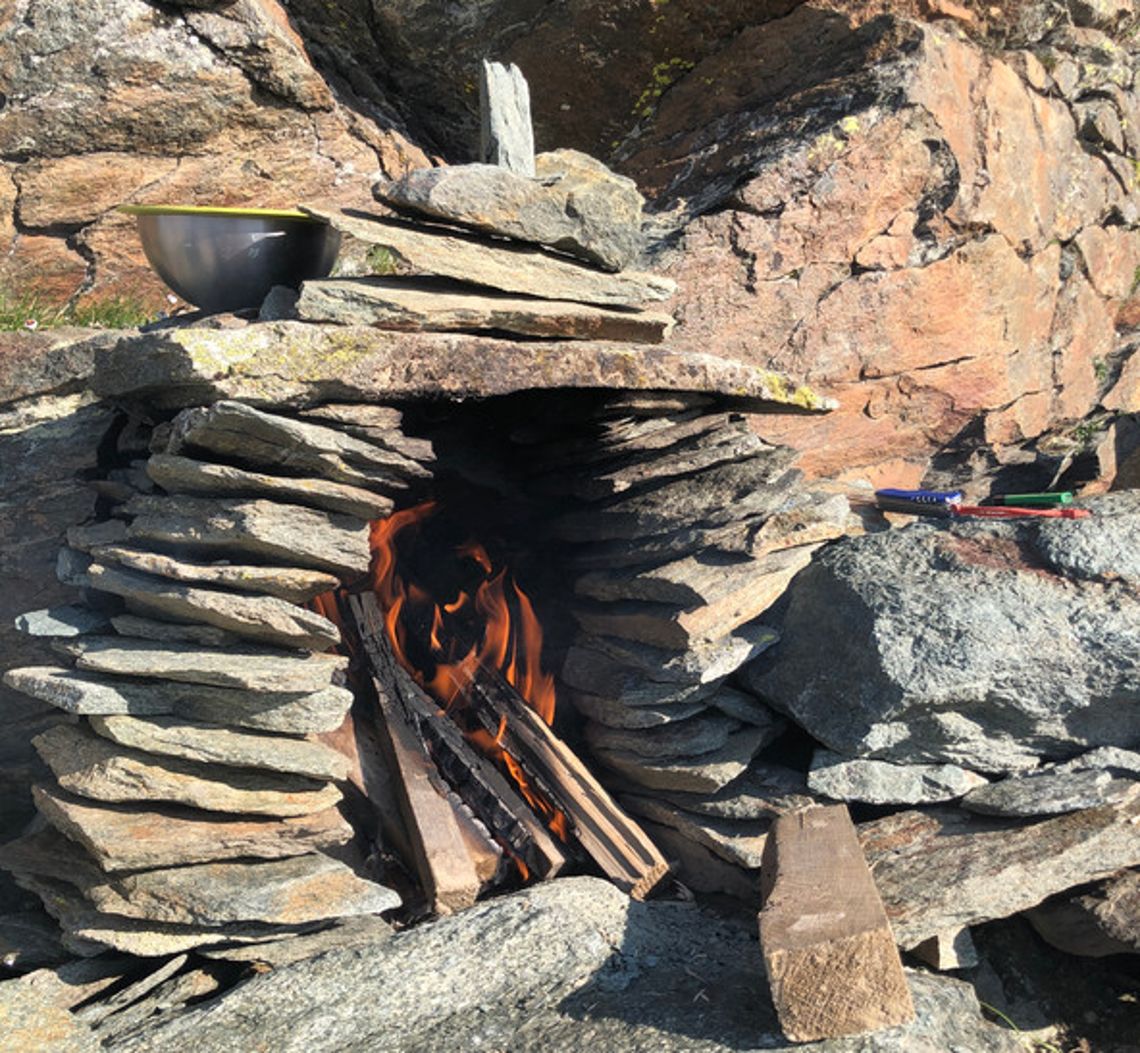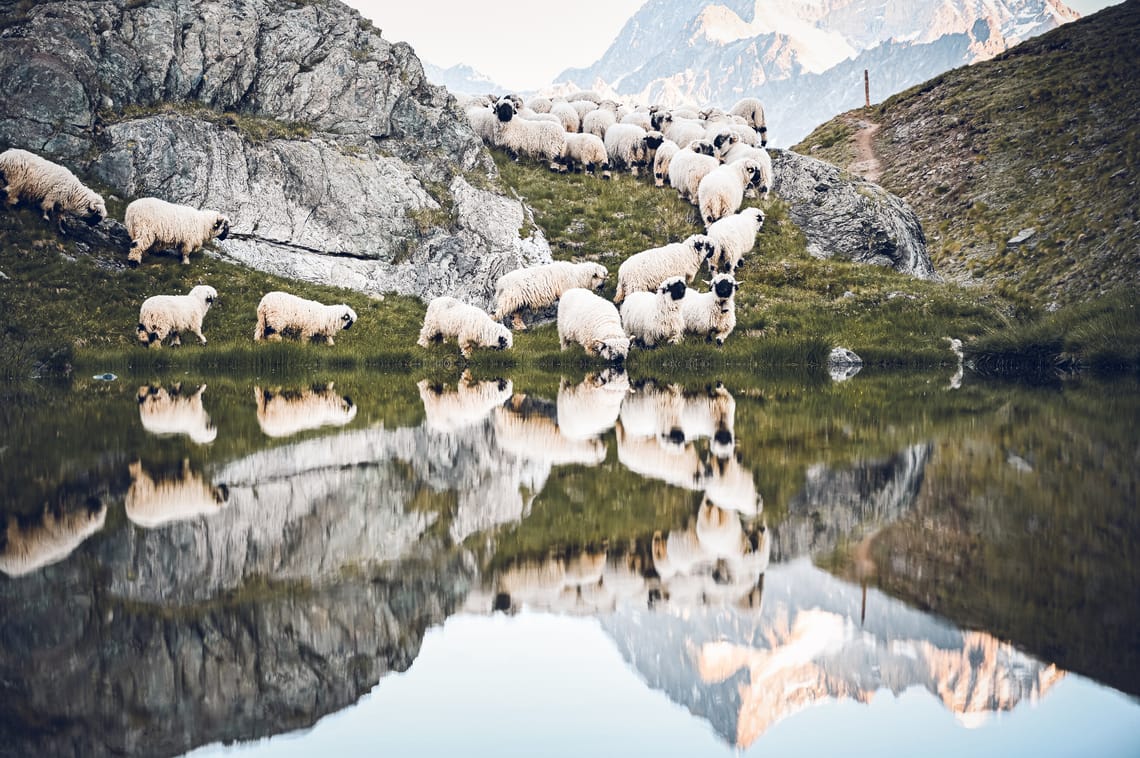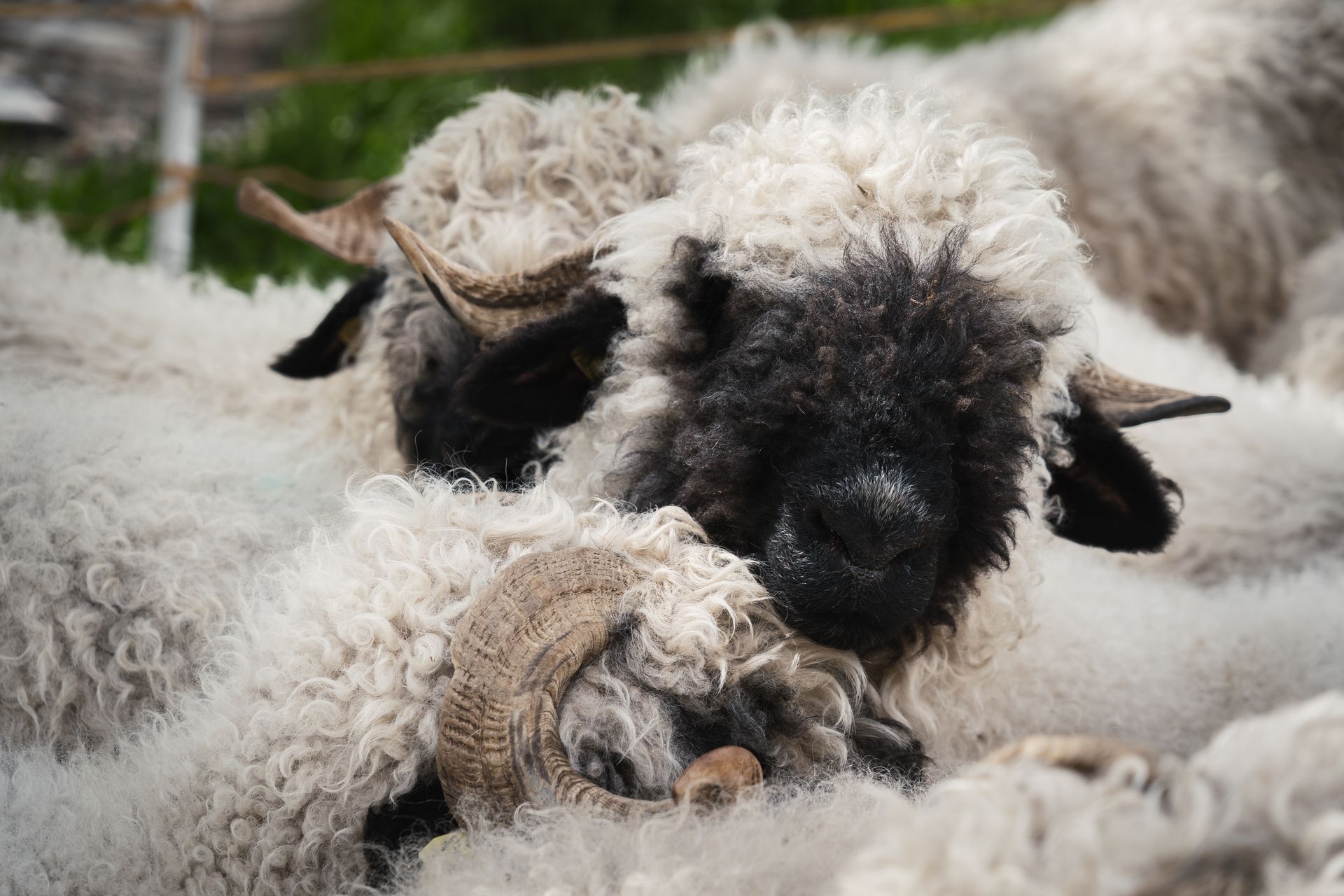
Der Hirtenalltag unserer Schafhirtin Deborah
Deborah berichtet über den Alltag als Hirtin auf der Alp am Gornergrat.
So viel habe ich erlebt in diesem Sommer, unglaublich einzigartige Momente, Stimmungen, Begegnungen und Szenen. Kleine und grosse Wunder und natürlich ein Haufen Herausforderungen: Von den aufwändigen Alltäglichkeiten, schwierigen Momenten mit den Schafen, hin bis zu den wilden Momenten am Berg - wenn die Natur sich austobt und vier starke Wände und ein robustes Dach über dem Kopf ganz wünschenswert wären.
Sommerliche Abenteuer auf fast 3000 Metern über Meer
Der Wechsel von den 2500m auf Riffelberg im Juli zu den fast 3000m ist ein Glück, aber ebenso eine Herausforderung. Die Luft ist nun wirklich dünn und immer kalt. Nur ganz wenige Stunden am Tag mag es etwas aufwärmen. Meist bin ich in meinem dicken Wollpullover unterwegs, um mich beim Laufen vor den kalten Gletscherwinden zu schützen.
Oft ist das Gras am Morgen von Reifen überzogen. Ich bin unendlich froh, über die Pistenanlagen Strom in meinem Wohnwagen zu haben, um den kleinen Raum zu heizen. Das Klima ist wild und oft kalt, ich lebe ohne fliessendes Wasser, ohne Badezimmer und ohne jeglichen Luxus.
Das Wasser hole ich von der Sessellift-Bergstation gute 10min entfernt. Jeder Wassertropfen ist heilig.
Die Schafe finden den "Rosenritz" einen tollen Ort und kommen oft leicht oder fast ganz selbstständig hoch - alles entspricht nun ihrem natürlichen Weiderhythmus: Morgens talwärts, dann am Schatten "hitzen" und abends wieder bergwärts. Die Nacht wollen die Schafe immer auf einer Erhöhung verbringen, wenn sie nicht bis zum Rosenritz kommen, finde ich sie auf den Hügelkuppen über dem Riffelsee.
Ich muss sie täglich 24 Stunden begleiten, bei jedem Wetter, 7 Tage die Woche. Das mache ich nicht immer in Person, sonst könnte ich hier in diesen Bedingungen nicht überleben. Ich führe sie morgens aus dem Nachtpferch, besuche sie um die Mittagszeit und am Nachmittag bei Meet the Sheep und suche sie abends wieder auf dem Riffelberg, dann bringe ich sie (ohne Hund!) zu ihrem Nachtpferch, wo sie die Nacht geschützt vor dem Wolf verbringen. Tagsüber überprüfe ich stets ihre Position per GPS. An Nebeltagen muss ich mehr Zeit bei der Herde verbringen, auch wenn es dann meist umso kälter und feuchter ist. Nachts schlafe ich wenige Meter neben den Schafen im Wohnwagen und überprüfe bei Glockengebimmel die Situation, falls ein Wolf auftauchen würde und ich Alarm schlagen müsste.
Durch die regelmässige Arbeit mit den Schafen wird meine Herde immer zahmer. Sie kommen von weit her auf mein Rufen. Einige sind mir so vertraut, dass ich sie von weitem erkenne und bei ihren Namen rufe. Dann kommen sie mir entgegen und rufen mich zurück.
Von unglaublichen Sonnenuntergängen und pechschwarzem Sternenhimmel
Ich erlebe hier oben weniger wilde Stürme als noch auf Riffelberg. Es wird endlich etwas ruhiger mit dem Wetter, dafür darf ich die unglaublichsten Stimmungen geniessen: Einen pechschwarzen Sternenhimmel mit der ganzen Milchstrasse.
Viele Freunde besuchen mich und eine kostbare Begegnung bereichert meinen ganzen Sommer: Manchmal backen wir Pizza im Steinofen oder grillieren auf der Feuerstelle, die ich neben dem Wohnwagen gebaut habe. Hin und wieder backe ich auch Brot in meinem Ofen - das ist wie ein Fest, denn frisches Brot am Berg ist eine Seltenheit!
Das Kreativsein kommt nicht zu kurz
Ich sammle und trockne Kräuter und mache hin und wieder längere Wanderungen, um den Berg noch besser kennenzulernen. Ich sammle farbige Steine, um daraus Pigmente zu machen und damit zu malen. Oft skizziere und schreibe ich in mein Skizzenbuch.
Gegen Ende Sommer finde ich hauchdünne Schieferplatten. Ich bringe sie zum Wohnwagen. Die gesammelten farbigen Steine zermahle ich zu Pulver, aus dem ich selber Farbe herstelle.
Auf die Steinplatten male mit den selbst gemachten Pigmenten (Farbpulvern) das Panorama vom Gornergrat. Es entsteht eine wunderschöne Werkserie, die im Sommer 2022 in der Sala Segantini in Savognin ausgestellt wird.
Wer ist Schafhirte?
Meet the Sheep wird zur Gewohnheit und weiterhin spannend, erfreulich und wertschätzend. Manche Gäste sind so besonders, dass sich in kurzer Zeit eine Art Freundschaft bildet. Manche Gäste sind von den lockigen, zutraulichen Schafen so bewegt, dass sie in Tränen ausbrechen oder mir ihr ganzes Leben erzählen. Und manche Gäste bleiben noch über Wochen mit mir in Kontakt und schicken mir ihre Bilder vom Gornergrat und den Schafen.
Mit dem fortschreitenden Sommer wird das Hirten immer aufwändiger. Dreimal hat es im Juli 2021 geschneit, ansonsten jeden Monat mindestens einmal. Das Gras wird rötlich und trocken, immernoch ein gutes Futter für die Schafe, doch sie ziehen nun auch weiter und verteilen sich manchmal in kleineren Gruppen. Ich bin sehr froh als mein Freund zu mir kommt und den aufwändigen Haushalt im Wohnwagen mit Wasser holen und kochen übernimmt. Es ist einfacher hier oben zu zweit. Wenn es Schwierigkeiten gibt beim Schafe hirten, hilft er mir ebenso.
Der September naht: Schafe zusammentreiben bei Einbruch der Nacht
Die Tage werden kürzer, kühler und das Gras wird durch ein paar Frostnächte braun. Auf einmal ziehen die Schafe abends immer weniger gern hoch und verbringen den Mittag wieder auf dem Riffelberg.
Das Hirten wird schnell sehr aufwändig, das Zusammensuchen der Schafe manchmal richtig beschwerlich. Immer öfter ist es schon Nacht, bis ich alle Schafe im Pferch habe. Der Sommer zieht sich zurück, die Tage werden nun rasch kürzer.
Ich möchte am liebsten noch lange hier oben bleiben, aber die Aussicht, dass ich hier möglicherweise bald richtig eingeschneit werden kann, finde ich dann auch wieder nicht so prickelnd. So liegt dann tatsächlich wieder Schnee, als wir den Pferch abräumen und wieder auf Riffelberg ziehen
Auf dem Riffelberg geht mitte September die Saison dann bei einem starken Schneefall zu Ende, wir ziehen mit der Herde zurück ins Tal, wo sie den Winter im Stall verbringen und die restlichen Tage ohne Schnee im Tal auf den Weiden um das Dorf.
Mehr Geschichten wie diese?
Melde dich für den Newsletter an und erhalte 4-6 Mal jährlich Neuigkeiten und Hintergrundgeschichten.
